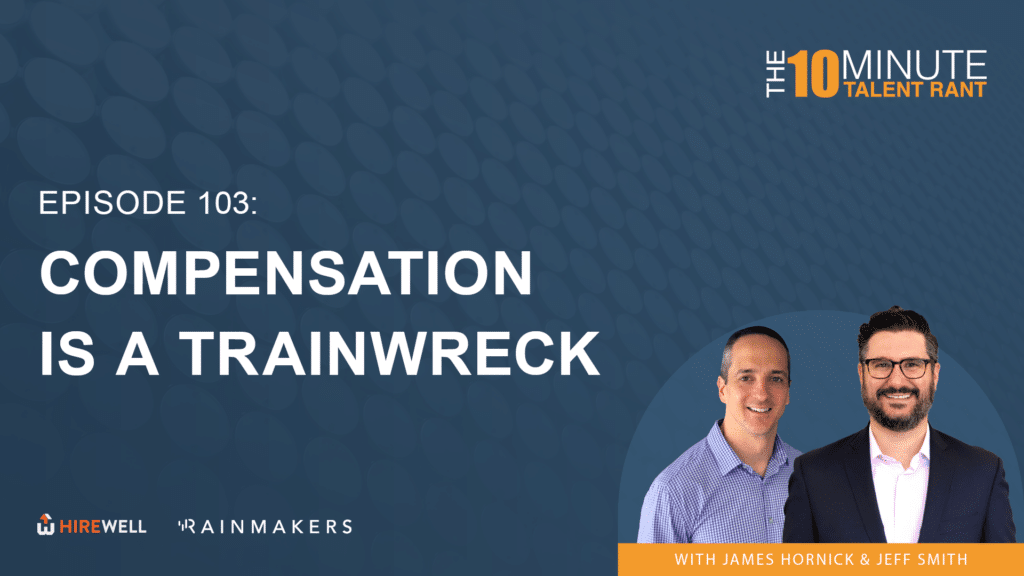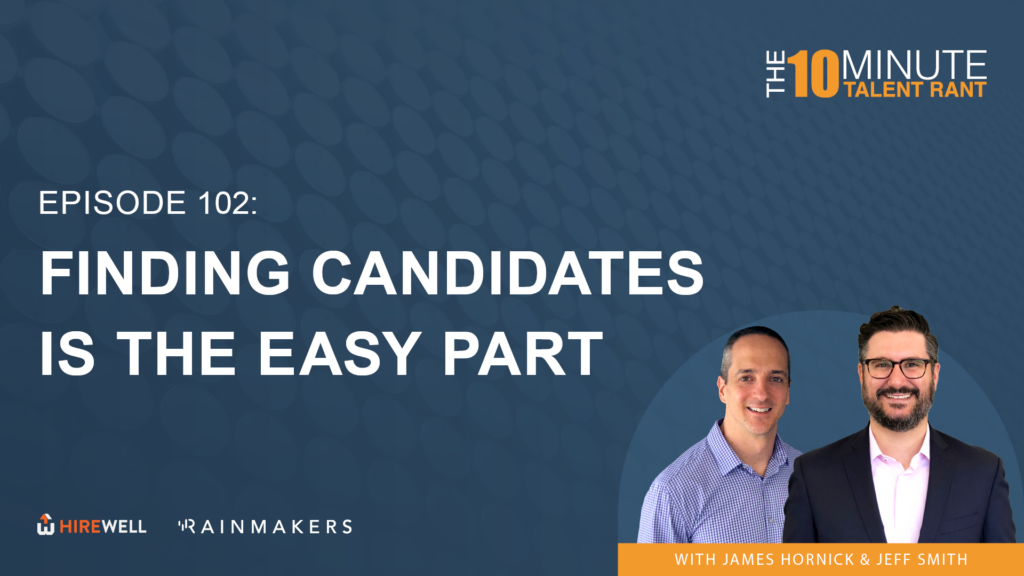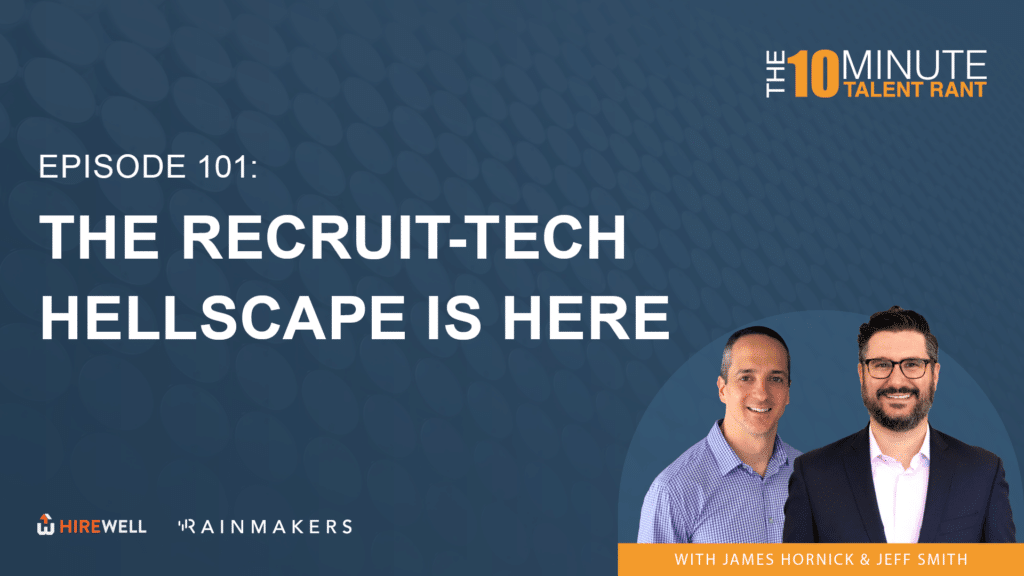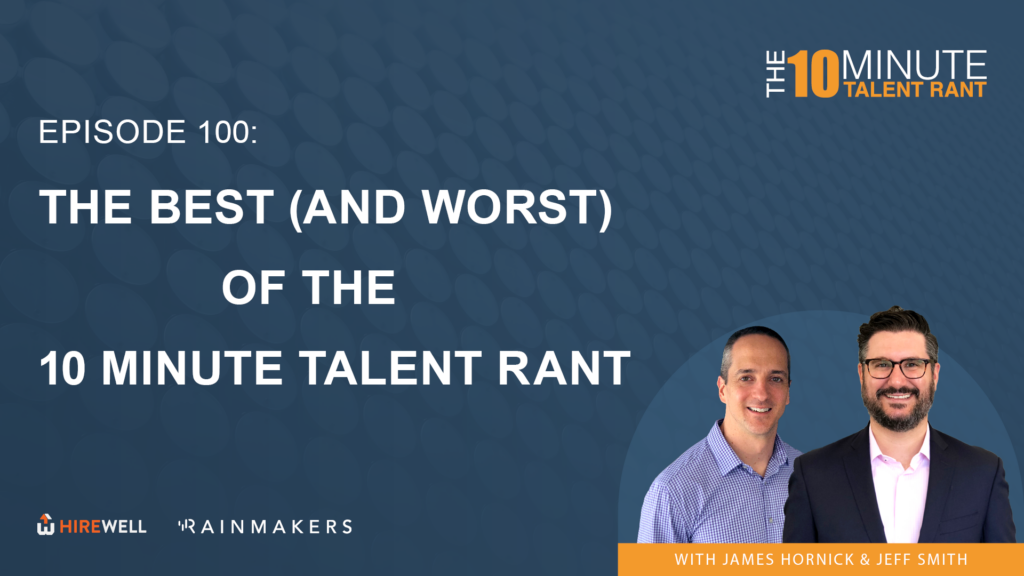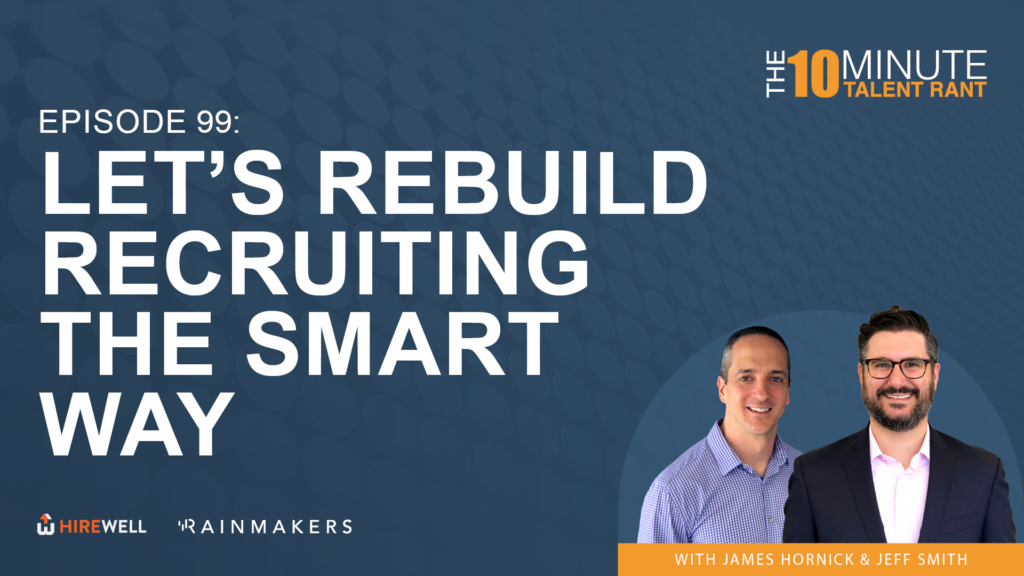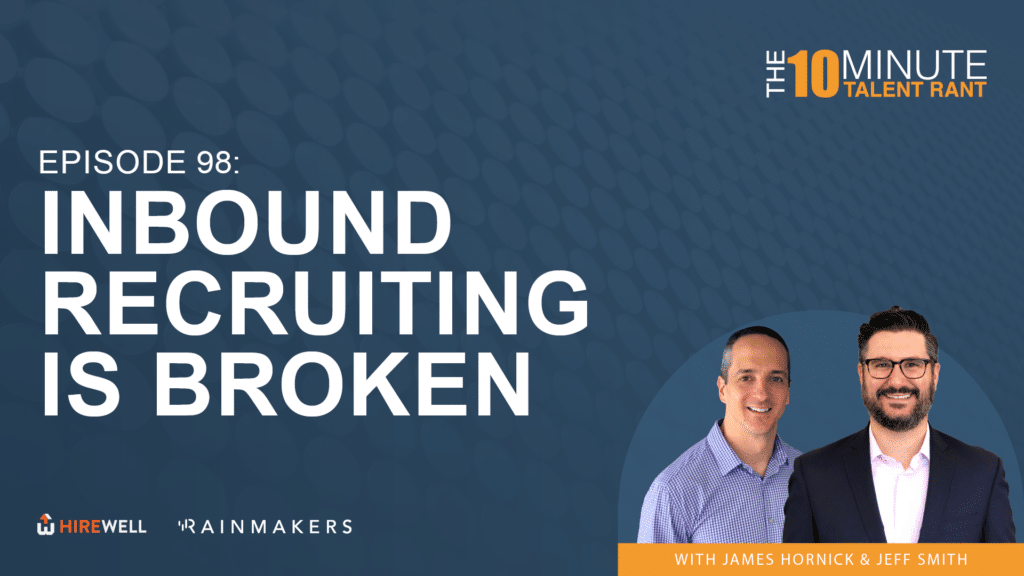All right. The 10 Minute Talent Rant is live. I’m James Hornick joined by Jeff Smith, and we are on the clock. The 10 Minute Talent Rant is our ongoing series where we break down things that are broken in the talent acquisition and hiring space. Maybe even pitch a solution or two. Before we dig in all of our content can be found on talentinsights.hirewell.com.
This week’s topic, Episode 84, Does Anyone Actually Have A Talent Strategy? What do you think? Some do. Not as many as you’d want. Some do. Some do. The answer is, the answer is yes, but some do. But, you know, it wouldn’t be snarky if we didn’t kind of slag the whole thing. In our-
On our last show, we talked about dumb hiring ideas and how they keep coming back. What we didn’t address is why the hell do they keep coming back? And it’s because talent acquisition is in like Groundhog Day. It’s- we’re just doomed to repeat the same mistakes over and over, forever, from lack of strategy. And I’ll speed run the last show real quick. We discussed poor feedback, aversion to fees, bad resume reviews, constantly changing requirements, sticking to contingent firms, even though it has not got the job done in the past and frustrates you, but you keep doing it anyway and it just makes everything worse.
So much worse. What do all of these things have in common? They’re all tactical. And I think companies, leaders sometimes confuse strategic with just transactional things. These are executional elements that companies, you know, perform poorly, but then they never actually evaluate all of the symptoms that made it all happen in the first place.
So, like I said, companies confuse these sorts of things all the time, and it’s very prevalent in HR and talent. And it’s why there’s so much room for improvement. I think what we want to do is talk about what actual-
like, what are the actual strategic things companies can do to change things in the current landscape of 2024? So, James, what you got? So, the first thing is including fractional work in your talent strategy, kind of on two levels. So in the past-
In the past, I’m not making this up in the past week, I’ve talked to six fractional execs. That was two CROs, two CMOs, one COO, one CHRO who are full up on clients. And it’s mutually beneficial for them and the companies they work with compared to full time execs. Like small to medium sized companies finally realized that creating their that, you know, their own go to market processes or tech processes, people processes and strategies, it doesn’t need to be the same person who oversees the day to day tactics or execution of what their team does.
In fact, it’s a lot of execs don’t want to do that. It’s two different skill sets. It’s two different jobs. You know, even if you combine all those things into one, it comes out to full time work. It’s not something that makes sense for either the company or the person, so. It’s why you hear in interview processes all the time, with executives specifically, like how in the weeds am I going to need to get, because they’re already thinking, ugh, is this two, three, four, five job? Anyway, continue. We’re going to relate this back to talent in a second here, but just kind of relaying what everyone’s realizing, from the company standpoint, if you only have 10 hours a week of strategy work, Why would you hire a full time resource for that?
You can instead develop the other people in your organization to do those other high value tasks that aren’t that strategy component. From the exec standpoint, it’s, if you’re great at strategy, but you don’t love the rest of the day to day, you want to focus most of your time- why would you focus your time on the things you don’t actually enjoy doing?
And there’s more money in it, if you can fill your schedule. Now, here’s the thing to remember, the same thing applies to talent acquisition, only the challenges to adopting this are reversed. Like I mentioned two CROs, two CMOs, a COO, CHRO. I didn’t mention talent, that didn’t come up. I haven’t talked to any fractional talent people.
When you hire those like the go to market functions, COO functions, there’s chronic overthinking. There’s a tendency to overhire someone you don’t actually need, at least need all full time wise, all that time for with talent acquisitions, the opposite, it’s chronic underthinking. It’s a tendency to not hire anybody at all with needed strategic experience that would set you up for success.
Yup. Absolutely. It’s how much- how much strategy is really needed in founding, HR, founding sales- bootstrapping through series B, maybe you’ve got your second seed. Like sell product, move product and scale. It’s really not that difficult. This all rings true on the execution side as well.
Recruiting is and always will be a timing game. So when you, we use this all the time with customers, the faucet on, faucet off analogy. If the faucets on, you can’t get enough help. 2021, early 2022, anyone who is remotely involved in hiring knows exactly what I mean. It was just, it was a complete arms race.
But when the work is done and that faucet shuts off. All of a sudden, all of these recruiting resources become that big old bullseye on the bottom line, which mid 2022 till now we’re seeing some good signs, but that’s what every recruiter is defining as the bloodbath, right? Fractional recruiting alleviates all of this. So it might just be a single person to get you through a surge. It might be a larger program that, you know, we or anyone else carves out to handle the function. The point is, whatever it is, can we finally agree that building and storing internal TA teams is absolutely not the right thing to do, right?
I would hope so. Yeah. The goal of fractional help, recruiting or otherwise, is to get the job done and get the hell out. That’s the whole point. There’s incentive to finish the job. If you’re an internal recruiter on a salary, I, they need a job. Filling everything as quickly as possible is completely counterintuitive to that instinct.
The point is the self preservation will always win in those instances. Yeah. Most ex recruiters become one of two things, an HRBP, because newsflash, secretly, that was the means to the end to get to that HR seat anyways, and TA really wasn’t their passion to begin with. Or two, they become project managers.
And unfortunately, they become project managers of very, very mundane, low value projects. Because that’s all the company can put them on whilst they become the bullseye. So even if that faucet comes back on and you set up an internal recruiter, some of those folks have moved far enough away from the daily grind that they have no intention of jumping back in anyway.
So you’ve completely destroyed the value of that person and put them into low value situation. So recruiters recruit. Done. Fact. Plain and simple. This job is about cultivating a Rolodex to “get lucky”, when the searches arise. No more, no less. The second thing I want to talk about is partner models that encourage optimal outputs.
I’ve said this a million times. Contingent recruiting is the dumbest business model in the history of business models. Companies are drawn to it because it looks like a risk free proposition. But Jeff, have you ever heard the term you can’t afford free? I sure have. It always bites you in the ass. What companies fail to understand is they’re actually encouraging firms to charge as much as possible while providing their worst possible effort.
Yes. So you’re paying for poor results, you’re overpaying for poor results. We’ve talked about this live very candidly more often with customers. It’s just because we and Hirewell firmly believe it. You’re not getting any additional value from that model. Two things, that you can do to alleviate that.
First, it’s flat fees instead of percentages. Anyone who, again, to describe this, if you haven’t worked with recruiters, a lot of it is, the fee is a back end fee based on the salary of the individual that you hire, and maybe it’s 20%, 25%, et cetera. If you put a flat fee on those hires and you work at volume, variable cost becomes much more fixed. And you do it, again, at volume, you could be talking six figure swings of volatility. Like it’s just, it doesn’t make business sense. And it’s kind of why none of this ever happened. If you make hiring, if you, if you make those fees flat, the CFO can look at and say like, all right, there’s a predictable model I can work on.
Yes. I’ve actually, I’ve been in this industry for so long working on things on a percentage basis. Like it dawned on me, like, how, like, you forget how insane it is, like, how can you do anything at scale when you don’t know when with variable costs? Like, it’s just not a good model. It’s not a good buying model.
The 2nd thing is retainers. Now, I want to make sure I’m kind of really clear about this. I’m not telling or suggesting that paying a retainer to anyone, like just any random firm you come across is going to ensure results. But what I am saying is the firms who have intentionally gone this route, to do, two things that contingent firms don’t.
Like if you talk to a firm that’s retained, talk to a firm that’s in containers, there’s two things they fundamentally do and believe in that contingent firms don’t. First is they view business with their clients as long term vs transactional. Yeah. They’re not here just to make one fill. They want all your business, but they want to earn all your business.
That’s the entire point of why they’re doing all this. They want to make sure that they have the ball, like, contingent firms really are just finding candidates and spamming them to as many like places they have loose agreements with and seeing if anything hits. That’s not who you want to partner with.
You want to partner with somebody who, yes, wants to make a lot of money from you, but they want to do it because they filled a boatload of positions over a long period of time. Second, when you do that, you only take business, we’re talking about the firms that work on retained business. They only work on business they know they can fill. They know they’re not wasting their time with other clients that aren’t serious with sucking hours out of their recruiters time. They’re only working with places they’re committed with. They know how to fill the roles, but also they have the time and resources available for. Nothing will sour and ruin a long term relationship than taking a retainer, not being able to do anything with it, which is why firms that go this route, don’t do that. At least not intentionally.
So it’s, like i said, it’s not like, it’s not just like paying the retainer isn’t the fix, but finding the firms that actually have that mentality and that mindset are the ones that can actually get the job done for you on time and on budget, et cetera. Yeah, all the retainer does is signify that you mean business, that you’re willing to pay for the expertise to poke holes in your own process.
That’s it. That’s all we’re asking. And it almost always results in a better hire. Look, partners, they don’t compete against each other. That’s the bottom line. Unless you’re an F1 driver, in that case, yes, you do compete against each other. But if you do, you just to all the points you just mentioned, you’re never going to achieve like the scale of quality that you’re looking for.
So inefficiencies don’t live in a vacuum. Working hours are not unlimited. Wasted effort turns into higher prices and lower quality because you’re like, “Oh, I’m not getting a return on my investment.” All hiring organizations hate that, yet they keep going back to the model. So you need to influence your team, your hiring managers, your internal recruiters, and your C suite to row in the same direction if and when you partner with an external recruiting firm.
All right. Jeff what’s the takeaways? Getting short on clock here. Yep. HR and strategy. It just needs to follow the same strategic roadmaps as other business initiatives. You need to seek out and we say seek, not hire. Seek out visionary leadership in these spaces. So, fractional leaders, fractional TA, don’t check boxes just to check boxes on what has always worked.
You need to give your people leadership the tools and the budget to truly solve the problems of each day. And newsflash, if there’s anything that the last four years have taught us, those needs change literally day to day, the leaders need to be nimble enough to see that stuff. Yeah. The second one, understand successful hiring doesn’t just happen.
Like hiring is not easy. Post a job, find me a resume, get another recruiter, if that’s the mode you’re in, there’s another level to this that you’re missing and you have to like understand there’s a gap you have, you have to get strategic with this, start thinking about hiring a strategic function if you want things to go well and be able to grow your organization longterm.
We are short on clock. Yeah. Thank you. We are short on clock. That’s a wrap for this week. Thanks for tuning in the 10 Minute Talent Rant part of the Talent Insight series, which is always available for replay on talentinsights.hirewell.com, as well as YouTube, Apple podcasts, Google podcasts, Spotify, and Amazon.
Jeff, thanks again, as always. Everyone out there, we will see you soon.







